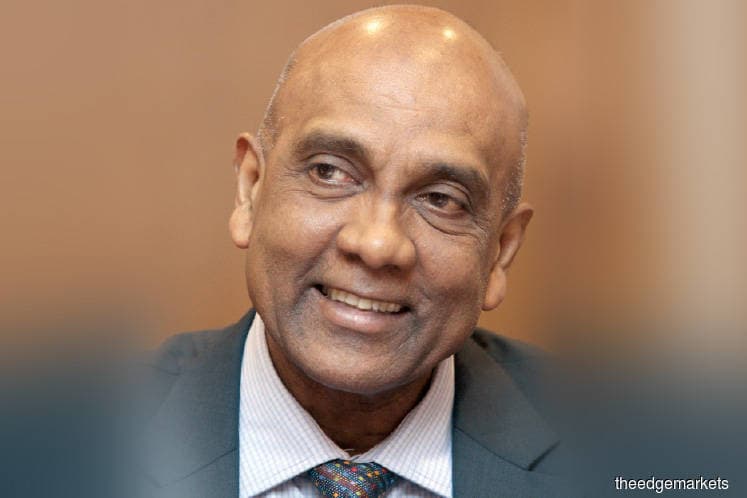
This article first appeared in The Edge Financial Daily on April 3, 2018
KUALA LUMPUR: Hibiscus Petroleum Bhd has reached 40% of its 2021 oil production target of 20,000 barrels per day (bpd), on completion of a 50% stake buy in North Sabah Enhanced Oil Recovery Production Sharing Contract from Shell last week, said its managing director Kenneth Pereira (pic).
The acquisition of its third oil and gas (O&G) asset, after those in the UK and Australia, has more than doubled its production to just under 9,000 bpd, from around 3,500 bpd previously, when it was backed only by its Anasuria cluster concession off the North Sea in the UK.
“The 20,000 bpd target is potentially achievable with the licences that we already have in the UK, Australia and Malaysia, and it assumes that we can get Australia (VIC/P57 exploration at the Gippsland Basin) into production,” Pereira told reporters at a company briefing yesterday.
He said Hibiscus had obtained all regulatory approvals to go into production in Australia, but the group is prioritising the enhancement of its two other producing assets to help the company reach the production target.
“We are looking at our capital allocation, where do we put our money right now, and we thought we should prioritise Anasuria and North Sabah,” he added.
The company plans to finish its sidetrack well-drilling on the Guillemot-A field in the Anasuria Cluster — an undertaking that it announced in February — by the first half of 2018. If all goes well, Pereira believes the job should be completed on schedule.
The group is also planning to raise US$50 million (RM193 million) to US$55 million of external funding for each of the two producing assets to spend over three years on improving cost-per-barrel by increasing production rate and lowering operating costs.
“The actual capital expenditure will be more than that. However, the amount we may have to raise through external funding will be limited to that,” said Pereira. “There will be enough cashflow generated to fund the gaps.”
While Pereira attributed part of Hibiscus’ ability to weather the 2014 O&G downturn to the absence of borrowings in its books, the group has now identified projects in Anasuria and North Sabah “which would make sense to fund with some level of debt”.
“That assumes the debt can be secured at a cheaper cost than our cost of equity,” Pereira said. He did not disclose the group’s internal gearing limit, but said it is a “conservative” figure.
All assets combined, Hibiscus now has proven and probable (2P) net reserves of just under 50 million barrels, less than half of the group’s 2021 target of 2P reserves of 100 million barrels.
To reach that target, Pereira said the group will look into assets that can still be profitable if oil price hits US$50 to US$55 per barrel, despite its expectation that oil price will be sustainable at current levels.
“The focus for oil producers now is to be a low-cost producer. We will continue staying around areas where we have some human infrastructure, where our teams are present,” he added, namely in Australia, the UK and Malaysia.
Hibiscus has improved the production cost in Anasuria to US$15 to US$20 per barrel from “the high twenties” after some asset enhancement activities, said Pereira, while the North Sabah asset has a production cost of around RM60 (US$15) per barrel. The estimated production cost in Australia, meanwhile, is higher than both, he said.
“What we learned from the downturn is the focus should be on cash generation capacity. Let’s focus on Ebitda (earnings before interest, taxes, depreciation and amortisation).
“[There are] so many paper entries into a company’s profit and loss [statement] today; the numbers may look strong but the cash balance may not be that great. We want to make sure our operational cashflow is strong.”
Hibiscus has been profitable for eight consecutive quarters, thanks to its Anasuria asset. However, even with the addition of North Sabah, the group will not see any dividend payout until at least next year, said Pereira.
“If we have 12 or 15 quarters of strong cashflow, then we can look at it (dividend). We’ve shown by reinvesting our cash into the company, the value to the company created is far more than giving out dividend to shareholders.
“Dividend will come when we are not going back to the market for [more] placements. [For now,] we can confidently say we’ll not do a placement in three months.”
Nevertheless, he highlights the company’s fundamentals are “strong, for the first time”.
“If oil price remains where it is now, we are very comfortable.” At the time of writing, brent crude was trading at US$69.71.
Hibiscus’ share price, at a three-year high of 96 sen in January this year, closed at 85 sen yesterday — up some 91% from 12 months ago — with a market capitalisation of RM1.35 billion.